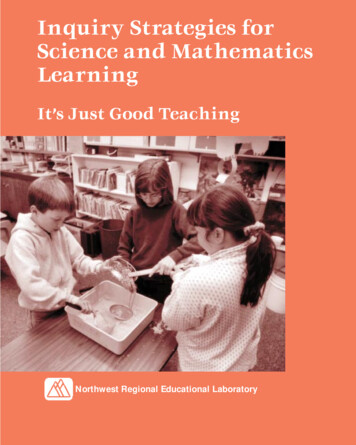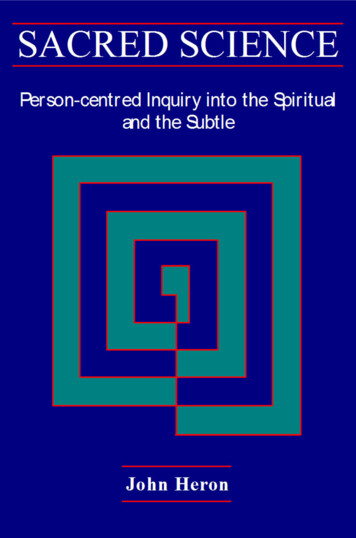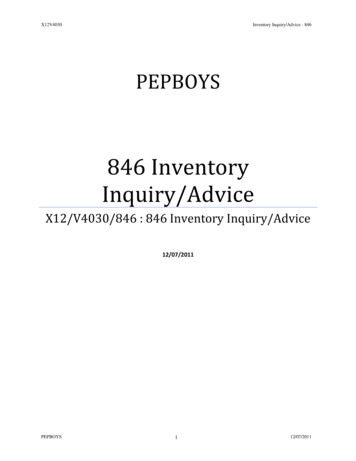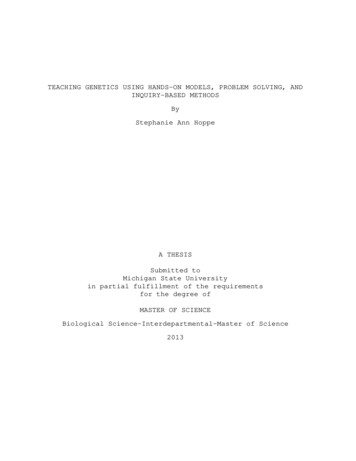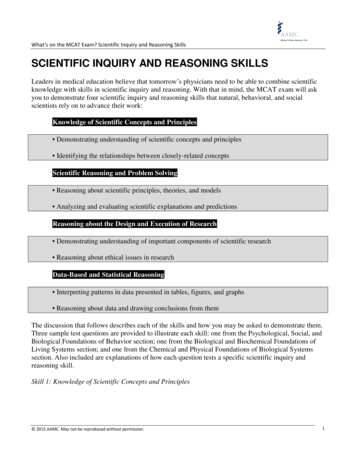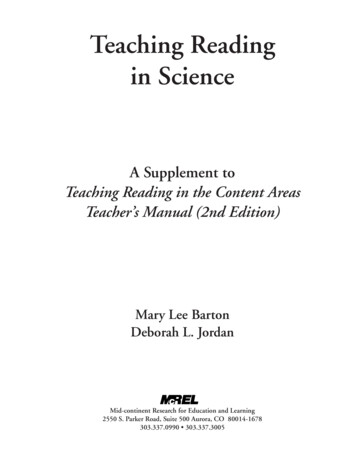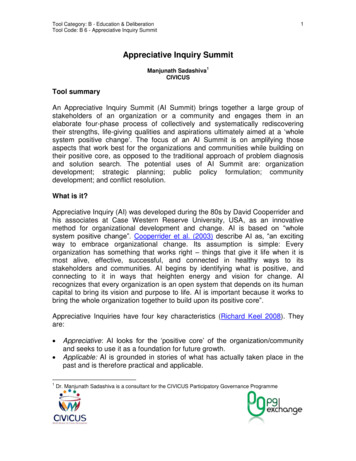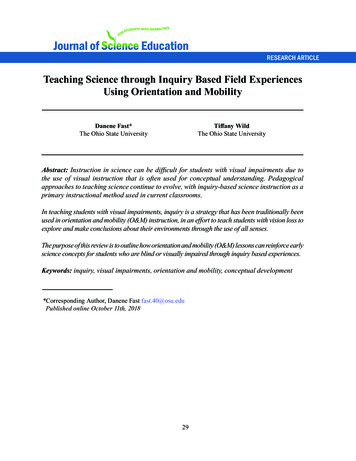
Transcription
RESEARCH ARTICLETeaching Science through Inquiry Based Field ExperiencesUsing Orientation and MobilityDanene Fast*The Ohio State UniversityTiffany WildThe Ohio State UniversityAbstract: Instruction in science can be difficult for students with visual impairments due tothe use of visual instruction that is often used for conceptual understanding. Pedagogicalapproaches to teaching science continue to evolve, with inquiry-based science instruction as aprimary instructional method used in current classrooms.In teaching students with visual impairments, inquiry is a strategy that has been traditionally beenused in orientation and mobility (O&M) instruction, in an effort to teach students with vision loss toexplore and make conclusions about their environments through the use of all senses.The purpose of this review is to outline how orientation and mobility (O&M) lessons can reinforce earlyscience concepts for students who are blind or visually impaired through inquiry based experiences.Keywords: inquiry, visual impairments, orientation and mobility, conceptual development*Corresponding Author, Danene Fast fast.40@osu.eduPublished online October 11th, 201829
Vol. 21, No. 1 - 2018Journal of Science Education for Students with DisabilitiesSCIENCE AND STUDENTS WITHDISABILITIESThe Individuals with Disabilities Education Improvement Act (IDEA) 20 U.S.C.§ 1400(c)(d) (2004) states that improvingeducational results for children with disabilities is an essential element of nationalpolicy that ensures equality of opportunity.Of the approximately 100,000 students withvisual impairments throughout the UnitedStates, few of them fully participate inscience instruction within their school settings (Beck-Winchatz & Riccobono, 2007).The National Science Teachers Association(NSTA) recognizes that, even with the bestof intentions, barriers to learning scienceare present and, as a result, issued a positionstatement to address inclusion of studentswith disabilities (National Science TeachersAssociation (NSTA), 2004).Using guidelines from IDEA and thenational science education standardspublished through the Next GenerationScience Standards (NGSS) (2013), NSTA’sposition paper includes a number ofrecommendation topics to ensure studentswith disabilities are integrated into science.These recommendations include: (a) useof strategies to overcome educational andphysical barriers, (b) selection of sciencecurriculum to promote accessibility andinclusiveness of people with disabilities,(c) development of assessment tools thatare accessible for all students, (d) useof collaboration to overcome attitudinalbarriers about what is involved in teachingstudents with disabilities, and (e) promotionof science and science-related careers forstudents with disabilities (NSTA, 2004).30One specific area addressed within the NSTAposition paper, under the topic of collaboration, includes ensuring accessibility for students with a variety of disabilities by workingwith school staff to ensure that teachers areprepared to help students master the sciencecontent (NSTA, 2004). All educators, including professionals such as orientation andmobility specialists who work with studentswho are blind or visually impaired, should beaccountable to this standard (Smith, 2006).With creativity, collaboration, and review ofconcepts being taught across disciplines, thefield of orientation and mobility (O&M) canprovide experiences that help students withvision loss to develop a conceptual framework for science concepts.SPECIALIZED NEEDS OFSTUDENTS WITH VISUALIMPAIRMENTSResearch has found that general educationteachers are not prepared to teach studentswith visual impairments (Norman, Caseu, &Stefanich, 1998; Kahn & Lewis, 2014) whileteachers of students with visual impairmentsare ill-prepared to teach science, technology,engineering, and mathematics (STEM)content (Kapperman, Heinz & Sticken, 2000).Therefore, there is a divide in order to meet theneeds of students with visual impairments.However, if content experts work togetherwith the specialists who provide services tostudents with visual impairments, all involvedwith the educational process will benefit.The students will get the content deliveredin an accessible manner while the generaleducation teacher, in this case the scienceteacher, can benefit from collaborating withan expert who recognizes and addresses theneeds of students with visual impairments.
Teaching Science through Inquiry Based Field Experiences Using Orientation and MobilityBecause much of what is learned withinclassroom settings is visual, specializedadaptations are used to educate students withvision loss. Students with visual impairmentshave unique needs that stretch beyond thoseof other low incidence populations, includingcompetency skills sets that go beyond thecore materials developed for students withingeneral education. Under the law, the IDEAmandates that functional outcomes, as well asacademic outcomes, are addressed in everyindividualized education program (IEP) forstudents categorized within special education(IDEA, 2004). In addition to addressing thedemands of a “typical” educational curriculum,administrators and IEP team members servingstudents with visual impairments must alsoconsider accommodations that address accessto the expanded core curriculum (ECC).First formulated by Hatlen (1996), theexpanded core curriculum (ECC) is anestablished set of specialized skills forstudents with visual impairments. It wasestablished because students with visionloss are unable to observe the non-verbalbehaviors and actions of others, affectingthe manner in which incidental skills arelearned (Allman & Lewis, 2014). Designedto go beyond the core components ofmath, reading, writing, and science toaddress essential areas and experiencesthat are unique to persons who are visuallyimpaired (Lohmeier, Blankenship, &Hatlen, 2009; Pugh & Erin, 1999), theECC addresses functional outcomes forstudents with visual impairments. O&M isone section of the ECC that addresses theability to move about in home, school, andcommunity settings. Skills within the O&Mcurriculum are ideally taught by certifiedspecialists trained in the discipline oforientation and mobility, who work closelywith parents and school professionals toadapt environments and support studentlearning across settings (Cmar, GriffinShirley, Kelley, & Lawrence, 2015).WHAT IS ORIENTATION &MOBILITY?O&M is a related service provided to studentswith vision loss in school settings by specialistswho are trained to teach skills associated withO&M; these skill sets are addressed throughthe individualized education plan (IEP).Orientation and mobility specialists focuson two components of learning: (a) knowingone’s position in space and keeping track ofhow position changes with movement and (b)the physical act of traveling from one placeto another. Through concepts associatedwith these components, individuals whoare visually impaired are taught to travelsafely, efficiently, independently, andgracefully as possible (Ambrose-Zaken,Calhoon, & Keim, 2010).While O&M is a part of the ECC and, theECC is “designed to go beyond the corecomponents of math, reading, writing, andscience,” there is crossover that can beestablished between the disciplines of O&Mand science. Components of the O&Mcurriculum can be naturally incorporatedinto science curriculum reflective of NGSSand can be taught in collaboration with thegeneral education teacher (Sapp & Hatlen,2010). By examining O&M curriculumand texts (Blasch, Wiener, & Welsh, 2010;Progrund, et. al, 2012), one can identifymany science concepts that can be reinforcedthrough O&M instruction (Smith, 2006).31
Vol. 21, No. 1 - 2018Journal of Science Education for Students with DisabilitiesUSING INQUIRY BASED INSTRUCTION FOR SCIENCE AND O&MInquiry can be defined as diverse waysof studying the natural world in order todevelop knowledge and understandingof science concepts (National ResearchCouncil, 1996). This approach to learninghas emerged as a prominent technique usedto teach science in general education settings(Maroney, Finson, Beaver, & Jensen, 2003;Rizzo & Taylor, 2016; Scruggs, et al., 1993;Scruggs & Mastropieri, 2007). The use ofrelevant experiences – including connectionsbetween the daily experience of students andwhat they are learning – is one way to helpchildren make sense of their natural worldwithin inquiry-driven methods.Samarapungavan and colleagues (2015)state that engaging students in mindful,inquiry-driven, modeling activities helpsstudents to understand dimensions ofscience. Through the use of inquiry methodsfor learners of all levels, instruction is aimedat developing the skills and knowledgeneeded within given situations, throughmeaningful interactions. In these methods,a socially negotiated process emphasizesthe importance of using contextualizedapproaches within inquiry to impactstudent learning (Boyd & Richerson, 2005;Samarapungavan, Tippins, & Bryan, 2015).Inquiry-based instruction has been foundto beneficial to students with disabilities(Lynch, S., Taymans, J., Watson, W.,Ochesendorf, R., Pyke, C., & Szesze, M.,2007). Mastropieri (2005) reported thatbehavioral problems in the classroomlessened as a result of inquiry-basedteaching methods being used in theclassroom. Wild and Paul (2012) found32that 61.1% of the science classrooms whichincluded students with visual impairmentswere using inquiry-based science methodsas part of instruction.Contextualized approaches to learning arealso appropriate for students who are blindor visually impaired, as research has shownthat students with visual impairments haveconsidered science a difficult subject becauseof the reliance on visual instruction forthe teaching of concepts (Jones, Minogue,Oppewal, Cook, & Broadwell, 2006; Penrod,Haley, & Matheson, 2005; Sahin & Yorek,2009; Wild, Hilson, & Farrand, 2014). Use ofinquiry-based instructional methods used inscience are effective for students with visualimpairments (Erwin, et. al., 2001; Wild &Paul, 2012; Wild & Trundle, 2010a; 2010b).Activity-focused, inquiry-based instructiontechniques can facilitate the efforts ofteachers and specialists in making appropriatemodifications based upon individualizedneeds of students (Wild & Paul, 2012).In a further analysis of inquiry-based teachingmethods for students with visual impairments,it was noted there is a dearth of research.Inquiry-based instructional methods havebeen found to be beneficial to students withvisual impairments but have only beenanalyzed in teaching concepts of scale,environmental science, seasonal change,space, sound, geoscience, and biodiversityto students with visual impairment (Jones,Taylor, & Broadwell, 2008; Rule, 2011; Wild& Trundle, 2010a; 2010b; Wild, Hobson,& Hilson 2012; Wild, Hilson, & Farrand,2014; Hilson, Hobson, & Wild, 2016). Whileanalyzing field-based inquiry teaching, itwas found that inquiry-based methods werebeneficial in helping students overcome
Teaching Science through Inquiry Based Field Experiences Using Orientation and Mobilityscientific misconceptions while still holdingonto misconceptions of science conceptsthat were unique to those with visualimpairments (Wild, Hobson, & Hilson 2012;Wild, Hilson, & Farrand, 2014; Hilson,Hobson, & Wild, 2016). One study, directlyused the help of orientation and mobility(O&M) instructors to support the inquirybased learning that occurred in field-basedgeoscience (Wild, Hilson, & Farrand, 2014).The O&M instructors directly supportedthe content-instructions by helping studentsorient to different geologic phenomenasuch as caves, caverns, and fossil-rich sitesin order to assist in navigation and to helpstudents fully engage in the numerous fieldbased experiences with their peers.While an effective strategy for scienceeducation, inquiry can also be a key pedagogicalstrategy in teaching O&M; one that allowsstudents to explore and make conclusions abouttheir environments, through the guidanceof an orientation and mobility specialist. Inteaching students with visual impairmentswithin general education settings, using acrossover of concepts between O&M andscience – including a crossover of instructionalstrategies, such as inquiry-based education,can facilitate conceptual development.O&M CONNECTIONS TO SCIENCEForces and InteractionsStudents who are blind or visually impairedmust use a sense of touch to discover properties of their immediate surroundings; teachingstudents to use their sense of touch to meaningfully interact with environments is oneaspect of O&M training. Loomis and Lederman (1986) point out that touching involvesdetecting relative positions and movements ofparts of the body (Guth, Rieser, & Ashmead,2010). In order to become independent travelers, students who are blind or visuallyimpaired must experience environmentsthrough touch, recognizing how the proprioceptive integration of touch and movementin determines position in space. Integrationof scientific concepts of physical interactionsand analysis of these interactions in relationto force, students with vision loss can connectconcepts across disciplines.Beginning with basic science skills, suchas investigations that compare effects ofdifferent strengths or different directionsof pushes and analysis of data to determine if design solutions can change thespeed or direction of an object (NGSS,2013, p. 4), O&M activities can be usedin elementary lessons to reinforce theseobjectives. With minimal creativity andcollaboration between classroom teachersand O&M instructors, lessons that addressrecognition of landmarks and clues for orientation purposes, basic spatial awareness,directional/positional concepts, and timedistance concepts can also reinforce scientific concepts of forces and interactions.For example, exploration of forces andinteractions can be done on a playground(Fast & Wild, 2018). By taking the lessonoutside, students can engage in inquirybased experiences from the classroom tothe playground to address science and engineering practices. While the science teacherfocuses on push and pull with differentstrengths and directions, ability to changespeed or direction, and concepts of biggerpushes or pulls making things speed up orslow down, the O&M specialist can focus33
Vol. 21, No. 1 - 2018Journal of Science Education for Students with Disabilitieson discussion of relationships between thestudent and the environment with focus onthe push and pull of the long cane, typicallyused by students with visual impairments(Fast & Wild, 2018). The O&M instructor can work with the science teacher tohelp students identify what happens whenobjects are pushed or pulled, forces thatinteract within the environment, and howto “measure” the forces needed to speed upor slow down an object in motion.HabitatWithin O&M training, spatial updating andframes of reference within environmentsare two fundamental concepts important inunderstanding spatial orientation (Long &Giudice 2010). O&M lessons that addressenvironmental travel skills – includingresidential, urban, rural, and suburban environments, navigation within these settings,and use of cardinal directions to maintainorientation can also reinforce scientific concepts of habitat and how the environmentsare changed to address the needs of pedestrians (Hilson, Hobson, & Wild, 2016).NGSS standards addressing the concept ofhabitats state that to demonstrate mastery,students must construct arguments, supported by evidence, for how plants andanimals can change the environment to meettheir needs (NGSS, 2013, p. 7). Allowingstudents with vision loss who are alreadyparticipating in O&M lessons withinvaried community settings to expand theirconceptual knowledge by using inquirybased learning within these settings canimprove O&M concepts of environmentalFigure One – Forces and Motion: Push and Pull34
Teaching Science through Inquiry Based Field Experiences Using Orientation and Mobilityawareness and mental mapping skillswhile solidifying core science concepts(Hilson, Hobson, & Wild, 2016).For example, students can engage in inquirybased experiences in the outdoors by examining plants and animals in their natural environments, allowing for authentic experiencesthat are vitally important to the conceptualunderstanding of students with visual impairment. While the science teacher encouragesexamination of plants and animals in theirnatural environment and evidence for howthese plants and animals can change theirenvironment to meet their needs, the O&Minstructor can assist by helping students usetheir senses to observe characteristics of thenatural world within environments wheretravel skills are being taught.Similar to the research conducted by Hilson,Hobson, and Wild (2016), the O&M instructorcan support learning within field-based experiences, such as conversation parks, wildlifecenters, zoos and aquariums, or field stations.The O&M instructor can provide tactile maps,guidance in directional concepts, and help innavigation of complex terrain using modifiedtravel skills and equipment all while ensuring students are fully engaged in the scienceinstruction happening in these new environments. Specific to students with visual impairments, the O&M instructor’s curriculumdescribes how they need to prepare studentsto explore and predict naturally occurring patterns that can impact travel, such as plantsand tree roots. This requirement naturallyaligns with the science standards of observing and describing patterns in the naturalworld, allowing the science teacher and O&Minstructor to co-teach these concepts.Figure Two: Habitat35
Vol. 21, No. 1 - 2018Journal of Science Education for Students with DisabilitiesCONCLUSIONS“All educators, including professionals suchas orientation and mobility specialists whowork with students who are blind or visuallyimpaired, should be accountable to educationalstandards” (Smith, 2006, p. 161). Inquiry basedinstructional methods across the disciplines ofscience and O&M can provide a number ofhands-on experiences for students with visionloss, allowing students opportunity to investigate, explore, problem solve, and integrate scientific concepts into supervised travel routines.Through the use of collaboration between thescience teacher and the O&M instructor, students who are blind or visually impaired canbe provided with opportunities that imbedscience concepts into O&M training, providing an inclusive curriculum across disciplinesand unique opportunities for learning.REFERENCESAllman, C. & Lewis, S., Eds. (2014). ECCEssentials: Teaching the Expanded CoreCurriculum to Students with VisualImpairments. AFB Press: New York, NY.Ambrose-Zaken, G., Calhoon, C. & Keim,J. (2010). Teaching orientation andmobility to students with cognitiveimpairments and vision loss. In W. R.Wiener, R. L. Welsh, & B. B. Blasch(Eds.), Foundations of orientationand mobility, Volume 2, Instructionalstrategies and practical applications (3rded.) (pp. 420-461). New York: AmericanFoundation for the Blind.36Beck-Winchatz, B. & Riccobono, M.(2008). Advancing participation ofblind students in science, technology,engineering, and math. Advances inSpace Research, 42, 1855-1858.Blasch, B., Wiener, W., & Welsh, R. (Eds).(2010). Foundations of orientation andmobility, Volumes I & II (3rd Ed.). NewYork: American Foundation for the Blind.Boyd, R., & Richerson, J. (2005). Solvingthe puzzle of human cooperation. In S.Levinson & N. Enfield (Eds.), Evolutionand culture (pp. 105-132). Cambridge,MA: MIT Press.Cmar, J. L., Griffin-Shirley, N., Kelley, P.,& Lawrence, B. (2015). The role of theorientation and mobility specialist inpublic schools. Position paper of theDivision on Visual Impairments andDeafblindness, Council for ExceptionalChildren. Arlington, VA: Council forExceptional Children.Erwin, E., Perkins, T., Ayala, J., Fine, M., &Rubin, E. (2001). You don’t have to besighted to be a scientist, do you? Issuesand outcomes in science and education.Journal of Visual Impairment &Blindness, 95(6), 338-352.Fast, D. & Wild, T. (2018). Traveling withscience: Working with orientation andmobility specialists to make scienceaccessible for kindergarten studentswith visual impairments. Science andChildren, 55(5), 54-59.
Teaching Science through Inquiry Based Field Experiences Using Orientation and MobilityGuth, D., Rieser, J., & Ashmead, D. (2010).Perceiving to move and moving toperceive: Control of locomotion bystudents with vision loss. In W. R.Wiener, R. L. Welsh, & B. B. Blasch(Eds.), Foundations of orientation andmobility: Volume one: History and theory(pp.3-44). New York, NY: AmericanFoundation for the Blind.Hatlen, P. (1996). The core curriculum forblind and visually impaired students,including those with additionaldisabilities. RE:view, 28(1), 25-32.Hilson, M., Hobson, S., & Wild, T.(2016). Conceptual understandings ofstudents with visual impairments aboutbiodiversity across ecosystems. Journalof Blindness Innovation and Research,6(2). Retrieved from: 6/jbir0602tc.htmlIndividuals with Disabilities Education Act(IDEA), 20 U.S.C. § 1400 (2004).Jones, M.G., Minogue, J., Oppewal, T., Cook,M.P., & Broadwell, B. (2006).Visualizing without vision at the microscale:Students with visual impairments explorecells with touch. Journal of ScienceEducation & Technology, 15 (5/6),345-351. doi: 10.1007/s10956-006- 9022-6Jones, M.G., Taylor, A., & Broadwell, B.(2008). Concepts of scales held bystudents with visual impairments. Journalof Research in Science Teaching, 1-14.Kahn, S. & Lewis, A.R. (2014). Survey onteaching science to K-12 students withdisabilities: Teacher preparedness andattitudes. Journal of Science TeacherEducation, 25(8), 885-910. doi 10.1007/s10972-014-9406-zKapperman, G., Heinz, T., & Sticken, J.(2000). Mathematics. In A. J. Koenigand M. C. Holbrook (Eds.), Foundationsof education, volume two: Instructionalstrategies for teaching children and youthwith visual impairments. New York, NY:American Foundations for the Blind.Lohmeier, K., Blankenship, K. & Hatlen,P. (2009). Expanded core curriculum:12 years later. Journal of VisualImpairment and Blindness, 103(2), pp.103-112. Long, R. G. & Giudice, N. A.(2010). Establishing and maintainingorientation and mobility. In W. R.Wiener, R. L. Welsh, & B. B. Blasch(Eds.), Foundations of orientation andmobility: Volume one: History and theory(pp.3-44). New York, NY: AmericanFoundation for the Blind.Loomis, J. M., & Lederman, S. J. (1986).Tactual perception. In K. Boff, L.Kaufman, & J. Thomas (Eds.), Handbookof perception and human performance.Volume II: Cognitive processes andperformance. New York: Wiley.Lynch, S., Taymans, J., Watson, W.,Ochesendorf, R., Pyke, C., & Szesze,M. (2007). Effectiveness of a highlyrated science curriculum for studentswith disabilities in general educationclassrooms. Exceptional Children.73(2), 202223.37
Vol. 21, No. 1 - 2018Journal of Science Education for Students with DisabilitiesMaroney, S. A., Finson, K. D., Beaver, J. B.,& Jensen, M. M. (2003). Preparing forsuccessful inquiry in inclusive scienceclassrooms. Teaching ExceptionalChildren, 36 (1), 18-25.Mastopieri, M. (2005). Margo Mastopierion science education and students withdisabilities. In Carin, A., Bass, J., &Contant, T. (Eds.), Teaching science asinquiry (pp. 287-288). Upper Saddle River,New Jersey: Pearson Merrill Prentice Hall.National Research Council (NRC). (1996).National science education standards.Washington, DC: National Academy Press.National Science Teachers Association NSTA. (2004, May). NSTA PositionStatement: Students with Disabilities.Retrieved April 22, 2017, from spxNGSS Lead States. (2013). Nextgeneration science standards: Forstates, by states. Washington, DC;National Academies Press.Norman, K., Caseau, D. L., & Stefanich,G. (1998). Teaching students withdisabilities in inclusive scienceclassrooms: survey results. ScienceEducation, 82(2), 127-146.Penrod, W., Haley, C., & Mattheson, L.(2005). A model for improving scienceteaching for students with visualimpairments. RE:view: RehabilitatitonEducation for Blindness and VisualImpairment, 37(2), 53-58.38Pogrund, R., Sewell, D., Anderson, H., Calaci,L., Cowart, M.F., Gonzalez, C., Marsh,R.A., & Roberson-Smith, B. (2012).Teaching age-appropriate purposefulskills (TAPS): An orientation & mobilitycurriculum for students with visualimpairments (3rd Ed.). Texas School forthe Blind and Visually Impaired.Pugh, G. S., & Erin, J. (Eds.). (1999). Blind andvisually impaired students: Educationalservice guidelines. Watertown, MA:Perkins School for the Blind.Rizzo, K. L. & Taylor, J. C. (2016). Effectsof inquiry-based instruction onscience achievement for students withdisabilities: An analysis of the literature.Journal of Science Education forStudents with Disabilities, 19(1).Rule, A. (2011). Tactile Earth and SpaceScience Materials for Students withVisual Impairments: Contours, Craters,Asteroids, and Features of Mars. Journalof Geoscience Education, 59, 205-218.Sahin, M. & Yorek, N. (2009). TeachingScience to visually impaired students: Asmall scale qualitative study. US-ChinaEducation Review, 6(4), 19-26.Samarapungavan, A., Tippins, D., &Bryan, L. (2015). A Modeling-BasedInquiry Framework for Early ChildhoodScience Learning. In K. C. Trundle &M. Sackes (Eds.), Research in earlychildhood science education (pp.259-277). New York, NY: Springer.
Teaching Science through Inquiry Based Field Experiences Using Orientation and MobilitySapp, W. & Hatlen, P. (2010). The expandedcore curriculum: Where we have been,where we are going, and how we can getthere. Journal of Visual Impairments andBlindness, June 2010, pp. 338-348.Wild, T. A. & Paul, P. V. (2012). Perceptionsof science educational practices forstudents with visual impairments.Insight: Research and Practice in VisualImpairment and Blindness, 5(2), 93-99.Scruggs, T. E., & Mastropiero, M. A. (2007).Science learning in special education: Thecase for constructed versus instructedlearning. Exceptionality, 15(2), 57-74.Wild, T., & Trundle, K. (2010a). Talkingturkey: Teaching about NorthAmerica’s greatest observation storywith children with visual impairments.Journal of Visual Impairments &Blindness, 104(4), 198-201.Scruggs, T. E., Mastropieri, M. A., Bakken,J. P., & Brigham, F. J. (1993). Readingversus doing: The relative effects oftextbook-based and inquiryorientedapproaches to science learning in specialeducation classrooms. The Journal ofSpecial Education, 27(1), 1-15.Smith, D. (2006). Developing mathematicalconcepts through orientation andmobility. RE:view, 37(4), 161-165.Wild T., & Trundle, K. (2010b).Conceptual understandings ofseasonal change by middle schoolstudents with visual impairments.Journal of Visual Impairment &Blindness, 104(2), 107-108.Wild, T.A., Hilson, M., & Farrand, K. (2014).Preparing for an inquiry-based summercamp experience for students with visualimpairments: What do the campersthink? Journal of Blindness Innovation &Research, 4(2), 1.Wild, T., Hobson, S., & Hilson, M. (2012).Conceptual Understandings of Soundby Elementary Students’ with VisualImpairments. Paper presented atthe annual international meeting ofthe Association for Science TeacherEducators, Clearwater, FL.39
behavioral problems in the classroom lessened as a result of inquiry-based teaching methods being used in the classroom. Wild and Paul (2012) found that 61.1% of the science classrooms which included students with visual impairments were using inquiry-based science methods as part of instruction. Contextualized approaches to learning are
